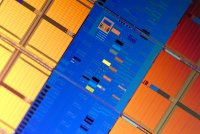Intel announces new-generation chips
Intel reveals details about next-gen Penryn processors, along with its roadmap for its Nehalem chips.

Chip giant Intel has revealed detail of its next two processor lines - codenamed Penryn and Nehalem.
The new chips will be based the 45nm fabrication process using Intel's newly developed metal-gate transistors that the company describes as 'revolutionary'.
Penryn parts are scheduled to hit the market in the second half of this year, with the Nehalem CPUs appearing at an unspecified point in 2008.
Penryn is based on the existing Core microarchitecture, with larger Level 2 caches of 6MB for dual-core and 12MB for quad-core, plus a new set of SSE (streaming SIMD extension) instructions, giving us SSE4. Clock speeds will exceed 3GHz and the front side bus speed will increase to 1,600MHz.
On the Nehalem front, the details were little short of a revelation. As well as a totally new CPU microarchitecture, Intel will be abandoning the traditional FSB (front side bus) in favour of a completely new platform approach. A serial point-to-point link will replace the FSB, and the system's memory controller will be integrated into the CPU.
This effectively means Intel is adopting the basic platform architecture AMD has been using in its Athlon 64 and Opteron processors for years, despite Intel's protestations that the front side bus architecture was fit and well.
A further surprise came with the announcement that it will produce a variant with graphics processing integrated into the CPU, eliminating the need for a separate graphics card.
Get the ITPro daily newsletter
Sign up today and you will receive a free copy of our Future Focus 2025 report - the leading guidance on AI, cybersecurity and other IT challenges as per 700+ senior executives
Stephen Smith, vice president of Intel's digital enterprise group was cagey about whether Penryn chips will work with current motherboards, confirming that the processors will fit the current LGA775 sockets but pointedly failing to say whether existing motherboards would accept the new parts as a drop-in replacement.
The new platform architecture required for Nehalem parts means that new motherboards and new memory will definitely be required.
-
 Should AI PCs be part of your next hardware refresh?
Should AI PCs be part of your next hardware refresh?AI PCs are fast becoming a business staple and a surefire way to future-proof your business
By Bobby Hellard Published
-
 Westcon-Comstor and Vectra AI launch brace of new channel initiatives
Westcon-Comstor and Vectra AI launch brace of new channel initiativesNews Westcon-Comstor and Vectra AI have announced the launch of two new channel growth initiatives focused on the managed security service provider (MSSP) space and AWS Marketplace.
By Daniel Todd Published